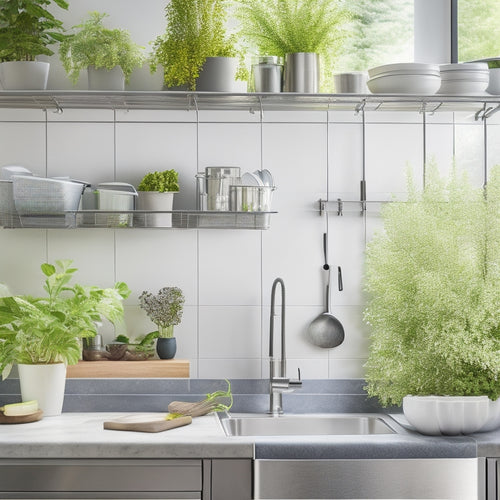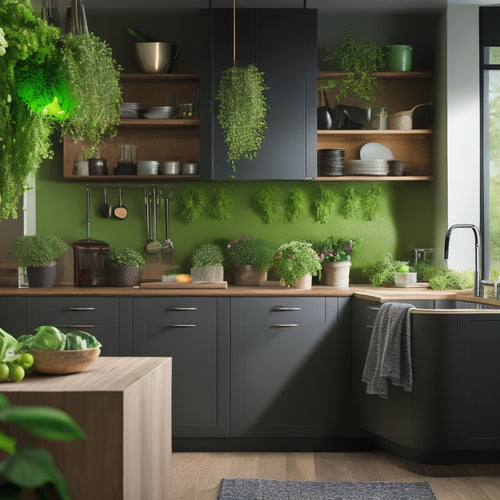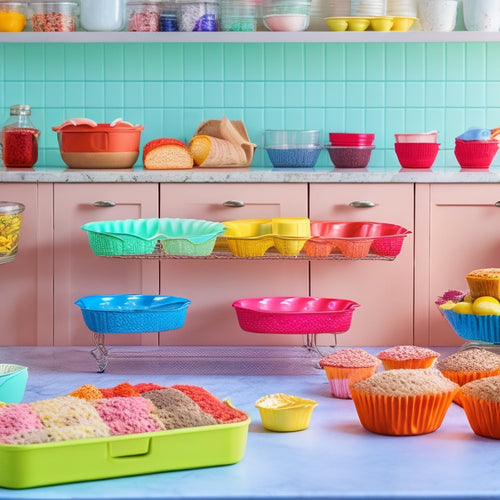
Optimizing Small Kitchen Spaces: Why Less Is More?
Share
You're about to discover that the key to optimizing your small kitchen space lies not in adding more, but in streamlining what you already have. Start by purging unnecessary items, and adopt a minimalist mindset to prioritize essentials. Then, optimize your cabinet storage by assigning a home to each item, and utilize vertical wall space for additional storage and counter space. By choosing multifunctional appliances and designating zones for tasks, you'll create an efficiency flow that makes cooking, prep, and cleaning a breeze. As you simplify your kitchen, you'll find that less truly is more - and the secrets to maximizing your space are just ahead.
Key Takeaways
• Purge unnecessary kitchen items to create a more efficient organization system and reduce visual clutter.
• Optimize kitchen cabinet storage by assigning a home to each essential item and utilizing custom shelving.
• Leverage vertical wall space for additional storage and counter space to maximize kitchen functionality.
• Choose multifunctional appliances to save space, reduce clutter, and promote efficiency in the kitchen.
• Designate zones for tasks to create an efficiency flow and navigate the kitchen with ease.
Purge Unnecessary Kitchen Items
Get rid of any kitchen gadgets, appliances, or cookware that you haven't used in the past year, as they're likely cluttering your space without serving a purpose. Adopting a minimalist mindset will help you prioritize what's truly essential in your kitchen. By letting go of unnecessary items, you'll create a more efficient organization system that makes the most of your limited space.
Decluttering your kitchen will have numerous benefits. You'll reduce visual clutter, making it easier to focus on the task at hand. Functional simplicity will also make meal prep and cooking more enjoyable, as you'll have a clear sense of what you need and where to find it.
With a more streamlined space, you'll be able to serve others more effectively, whether it's whipping up a quick breakfast for your family or hosting a dinner party for friends.
Optimize Kitchen Cabinet Storage
You're now left with a decluttered kitchen, and it's time to maximize the storage potential of your cabinets by assigning a home to each essential item. This is where custom shelving comes in – it's a game-changer for small kitchens. By installing shelves that fit your specific needs, you can make the most of your cabinet space.
| Cabinet Zone | Assigned Items |
| Upper Cabinets | Infrequently used items (e.g., special occasion dishes) |
| Lower Cabinets | Heavy items (e.g., pots, pans) and cooking essentials |
| Drawer 1 | Utensils and gadgets |
| Drawer 2 | Cooking utensils and spices |
With your shelves and drawers organized, it's time to add some finishing touches. Drawer dividers will keep your utensils and gadgets tidy, making them easy to find when you need them. By designating a specific zone for each item, you'll be able to access what you need quickly and efficiently. This thoughtful approach to cabinet storage will make your small kitchen feel more spacious and functional, allowing you to serve others with ease.
Utilize Vertical Wall Space
Frequently, the most underutilized area in small kitchens is the vertical wall space, which can be leveraged to create additional storage and counter space. By installing wall hooks, you can hang pots, pans, and utensils, freeing up cabinet space and adding a touch of visual appeal to your kitchen.
Consider vertical gardening, where you can grow herbs or greens on a trellis or wall-mounted planter, not only saving space but also adding freshness to your cooking.
Floating shelves are another great option to maximize your wall space. They provide additional counter space for food preparation, display decorative items, or store cookbooks and kitchen gadgets.
You can also use wall-mounted spice racks, knife holders, or a pegboard to keep frequently used items within easy reach. By utilizing your vertical wall space, you'll be amazed at how much more efficient and functional your small kitchen can become.
Choose Multifunctional Appliances
In a small kitchen, every inch counts, and opting for multifunctional appliances is a clever way to condense your kitchen's footprint while maintaining its functionality. By choosing appliances that serve multiple purposes, you'll free up valuable space and reduce clutter. This approach also promotes efficiency maximization, as you'll have fewer devices to operate and maintain.
Here are some examples of multifunctional appliances that can help you optimize your small kitchen space:
| Appliance | Functions | Benefits |
|---|---|---|
| Instant Pot | Pressure cooker, slow cooker, rice cooker, yogurt maker | Compact design, replaces multiple appliances |
| Toaster Oven | Toasts, bakes, broils, reheats | Saves counter space, energy-efficient |
| Food Processor | Chops, slices, shreds, purees | Streamlines food prep, reduces cleanup |
| Microwave-Toaster Combo | Microwaves, toasts, defrosts | Space-saving, convenient |
Designate Zones for Tasks
By assigning specific zones for tasks, such as a cooking zone, prep zone, and cleaning zone, you can efficiently navigate your small kitchen and make the most of its limited space. This task organization strategy helps you create an efficiency flow, allowing you to move seamlessly from one task to another without wasting time or energy.
Imagine having all your cooking essentials, like pots, pans, and utensils, within arm's reach in the cooking zone.
Next, envision a prep zone where you can chop, dice, and measure ingredients with ease.
Select Space-Saving Furniture
You'll maximize your small kitchen's potential by choosing multi-functional, space-conscious furniture that serves more than one purpose. This approach will help you create a more efficient and organized cooking space.
When selecting furniture, look for compact pieces that provide creative storage solutions. For instance:
-
Opt for a kitchen cart with built-in drawers and shelves to store utensils, cookware, and ingredients.
-
Choose a wall-mounted foldable table that can be easily tucked away when not in use.
-
Consider a microwave-toaster oven combo to reduce countertop clutter.
- Invest in a sink with built-in storage, such as a slide-out trash can or a shelf for cleaning supplies.
Implement a "One In, One Out" Rule
To maintain a clutter-free kitchen, adopt the 'one in, one out' rule, where every new item that enters your kitchen space must replace an old one to prevent overcrowding. This simple yet effective approach ensures that your kitchen remains organized and functional, even in a small space. By embracing this rule, you'll cultivate a mindset of minimalist organization, where every item has a designated place and purpose.
As you implement this rule, you'll start to notice a significant reduction in clutter and a boost in streamlined functionality. You'll be more mindful of the items you bring into your kitchen, and you'll be more intentional about the items you keep. This, in turn, will free up valuable space and reduce visual noise, making it easier to focus on cooking and serving others.
Edit Kitchen Countertop Clutter
Clearing the clutter on your kitchen countertops is an essential step in creating a sense of openness and flow in your small kitchen space. By doing so, you'll make meal prep and cooking a breeze, and create a more enjoyable experience for yourself and those you're serving.
Here are some emotional benefits you'll experience when you edit your kitchen countertop clutter:
-
Reduced stress: A clutter-free countertop means less visual noise, making it easier to focus on the task at hand.
-
Increased productivity: With a clear surface, you'll be able to work more efficiently, getting meals prepared and served in no time.
-
Improved creativity: A decluttered countertop gives you the mental space to experiment with new recipes and cooking techniques.
- Pride of ownership: A tidy kitchen is a reflection of your hard work and attention to detail, giving you a sense of accomplishment and pride.
Create a Kitchen Workflow
Designating specific zones for food preparation, cooking, and cleanup helps establish a seamless kitchen workflow. By assigning tasks to specific areas, you'll optimize your space and reduce congestion. This thoughtful layout enables efficient meal prep, streamlined cooking processes, and a stress-free cleanup.
Here's a suggested kitchen workflow layout:
| Zone | Activities |
|---|---|
| Prep Zone | Chop, dice, marinate, and measure ingredients |
| Cooking Zone | Stovetop, oven, and cooking surfaces |
| Cleanup Zone | Sink, dishwasher, and trash/recycling |
| Storage Zone | Pantry, cabinets, and countertops |
| Serving Zone | Plating, garnishing, and serving dishes |
Frequently Asked Questions
How Do I Measure My Kitchen Space Effectively for Optimal Layout?
You'll want to measure your kitchen space effectively by mapping out the room's dimensions, noting door and window locations, and identifying functional zones to create a functional layout that maximizes space utilization and efficiency.
Can I Still Have a Kitchen Island in a Small Kitchen?
You can still have a kitchen island in a small kitchen, but consider island alternatives like a cart or console table, and portable solutions like a rolling butcher block or foldable workstations to save space.
Are There Any Affordable Space-Saving Kitchen Design Options?
You'll find budget-friendly storage solutions, like wall-mounted shelves and foldable tables, that maximize space without breaking the bank. Compact appliance solutions, such as mini refrigerators and microwave-toaster oven combos, will also help you save space and money.
How Often Should I Reassess My Kitchen Layout for Optimization?
You've got a million things on your plate, but reassessing your kitchen layout every 6-12 months is important for optimization; take accurate space measurements and evaluate your layout's efficiency to guarantee a seamless workflow that serves others with ease.
Can I DIY My Kitchen Optimization or Do I Need a Professional?
You can DIY your kitchen optimization with budget-friendly solutions, like creative storage hacks, but if you're hesitant, consider hiring a pro to maximize your space and guarantee a functional, efficient layout that serves you and others.
Related Posts
-

Wall-Mounted Dish Drainer Racks for Kitchens
Wall-mounted dish drainer racks are a game changer for your kitchen. They maximize vertical space, freeing up preciou...
-

Rechargeable Under-Cabinet Lighting for Sustainable Kitchens
Rechargeable under-cabinet lighting is ideal for your sustainable kitchen. You'll enjoy energy efficiency with LED te...
-

Roll-Out Trays for Organizing Baking Supplies
Roll-out trays are perfect for organizing your baking supplies, making your kitchen more efficient. They maximize spa...


